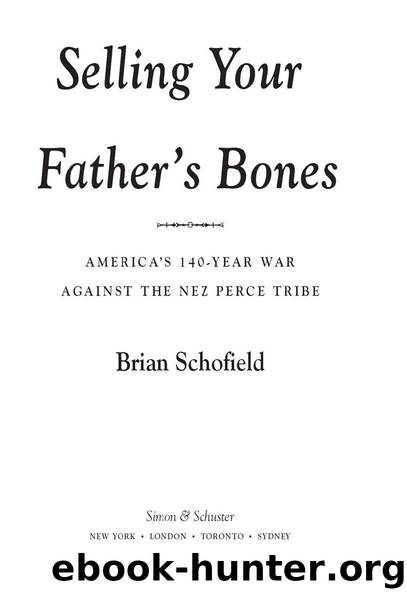Selling Your Father's Bones by Brian Schofield

Author:Brian Schofield
Language: eng
Format: epub
Publisher: Simon and Schuster
Published: 2013-07-15T00:00:00+00:00
“They were just women, children, and old men—that’s what she used to say.” Cheryl Holden Rice sat in her garden bench, her narrow hands in constant motion as she delved into her favorite topic: a family history that stretched back to the very settlement of the Bitterroot. “For the settlers, you see, it was just like the Native Americans—you had to know your family’s history, everyone you were related to, because you didn’t want to marry them!” Cheryl’s great-grandmother, Martha Burton, was a young girl who’d been huddled into Fort Owen as the Nez Perce passed by. “She remembered being evacuated to the east side of the valley in 1877. She actually looked Indian herself—her mother had been killed the year before because she was a Cherokee, and this was after Little Bighorn. And she remembered that from Fort Owen you could see the Nez Perce walking past on the other side, and she saw all the people and the horses and the clouds of dust, and she remembered thinking, ‘But…they’re just women and children, and old men?’”
Cheryl’s ancestors had been friends to both the Nez Perce and the Salish prior to the outbreak, and they fought hard to prevent the later eviction of Charlot’s band from the valley. Now, from her home high on the eastern flank of the valley, Cheryl was fighting against the latest assault on the once impregnable harmony of the Bitterroot.
“We can save this as it is,” she said, looking out over the patchwork valley. “But see that road down there? That’s now a bumper-to-bumper ribbon of lights. With all the pollution, and the dust from the construction trucks, our poor horses couldn’t breathe—we had to destroy them.”
Below her, the Bitterroot was becoming a ruburb—defined as where you move to after the suburbs, then the exurbs, feel too cramped. It’s an area that retains some of the characteristics of the countryside—few shops and a long drive to work, for example—while still being predominantly asphalt and front lawns. In the 1990s Cheryl’s county had seen a 44 percent increase in its population, and between 1992 and 1997 alone it had lost almost a quarter of its farmland to development—a significant slice when you consider the planning industry commonplace that the first 5 percent of rural development does half the damage. This was far from unique, as sprawl is the defining characteristic of the modern American geography. The urbanized nation expanded its footprint by over 300 percent between 1950 and 1990, while the urbanized population grew by just 80 percent, and this expanse became exponential in the 1990s, when over 3.2 million acres of rural America was paved over every year.
But the Bitterroot was getting hit particularly hard. The developers had exploited Montana’s considerable surviving natural attractions and its feeble planning laws to turn farms into cookie-cutter subdivisions or sprawling trophy ranches, heaping problems upon the valley as they went. The valley’s water table had become depleted—the river was already overirrigated—and by the late 1990s the Bitterroot, once a symbol of the Big Sky State, had developed an intermittent smog problem.
Download
This site does not store any files on its server. We only index and link to content provided by other sites. Please contact the content providers to delete copyright contents if any and email us, we'll remove relevant links or contents immediately.
| Africa | Americas |
| Arctic & Antarctica | Asia |
| Australia & Oceania | Europe |
| Middle East | Russia |
| United States | World |
| Ancient Civilizations | Military |
| Historical Study & Educational Resources |
1787 by Nick Brodie(1229)
The 2012 Story by John Major Jenkins(1064)
Bury My Heart at Wounded Knee by Dee Brown(1049)
Plagues and Peoples by William H. McNeill(904)
Witchcraft in Early North America by Alison Games(903)
Native American Folklore & Traditions by Elsie Clews Parson(863)
Tending the Wild by Anderson M. Kat(863)
Ada BlackJack by Jennifer Niven(854)
The Wisdom of the Native Americans by Kent Nerburn(838)
Empire of the Summer Moon by S. C. Gwynne(836)
0735220891 by Craig Johnson(810)
American Serengeti by Dan Flores(780)
They Called Me Number One by Bev Sellars(779)
The Truth About Stories by Thomas King(762)
The Killing of Crazy Horse by Thomas Powers(733)
An Inca Account of the Conquest of Peru by Ralph Bauer(718)
House of Rain by Craig Childs(715)
Sand Talk by Tyson Yunkaporta(701)
Unworthy Republic by Claudio Saunt(681)
